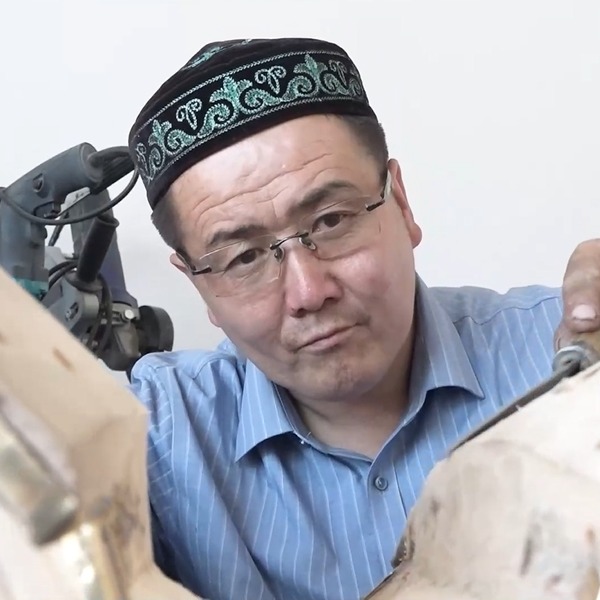Shiliuyun-Xinjiang Daily (Reporter Song Haibo) news: "Fine feathers make fine birds, and with a saddle on its back, the horse gallops with even more spirit!" On May 11, 2025, in the saddle-making workshop of Dongnangou Village, Xihu Street, in the Economic and Technological Development Zone (Toutunhe District) of Urumqi City, northwest China's Xinjiang Uygur Autonomous Region, the rhythmic clanging of tools blended with hearty laughter. Hazitayi Hamuzha, 48, was hammering away at iron pieces, while his old friends chimed in occasionally, creating a warm and lively scene. As a representative inheritor of Kazak traditional saddle-making craft, a municipal-level intangible cultural heritage project in Urumqi, he learned the skill from his grandfather as a child. The belief in crafting every saddle with care is a value from his ancestors.

Photo shows Hazitayi Hamuzha crafts a saddle at his workshop in the Economic and Technological Development Zone (Toutunhe District) of Urumqi City, northwest China's Xinjiang Uygur Autonomous Region. (Photo provided by Hazitayi Hamuzha)
Stepping into Hazitayi's workshop, the refreshing scent of wood shavings blends with the distinct aroma of leather. Saddle-making encompasses various crafts such as carpentry, embroidery, and leather braiding. The workbench is lined with tools like a small cutting machine, electric drill, awl, file, wrench, and more. "A saddle is the 'bridge' between a rider and a horse. Crafting a perfect saddle requires precision akin to tailoring—the curvature of the saddle must fit the horse's back perfectly. Even a slight error can cause friction, and the angle of the saddle bow directly affects riding comfort," Hazitayi explained. The key parameters of saddle-making are etched deeply in his memory. He still recalls how his grandfather would spend months, even a year, perfecting a single saddle, refining each step until it perfectly matched the horse's back.
After completion, the saddle must undergo the essential "practical test"— a trial on a horse. Hazitayi compares this process to "tailoring a formal suit for a horse," which requires multiple adjustments to ensure a perfect fit.
"In the past, we relied on the master's experience to adjust the saddle. Now, we let data guide us," said Hazitayi, as he pulled out professional measuring tools to meticulously record the horse's back width, curvature, and height. He paid close attention to how well the saddle frame fits the horse's back. Even a one-centimeter discrepancy prompts him to reheat the wood and reshape it. "Horses can't talk, but their backs give us feedback. The twitching of their muscles is like a review—it's as if we're dressing a horse in a custom suit. Every line must be just right; otherwise, it will cause chafing," he joked. The testing process often requires dozens of repetitions: first, he gently places the saddle frame and observes the contact area; then, he slowly applies pressure to check the weight distribution; finally, he simulates riding conditions to ensure long-term use without causing wear.
A complete set of horse gear includes over ten components, such as saddle pads, decorative saddle pieces, and stirrups, all working in harmony to ensure riding safety while embodying the "art of horseback." Hazitayi has turned this ancient craft into a "golden key" for villagers to increase their income. Under his leadership, residents of Dongnangou Village participate in the process: some crafting small saddle parts, others cutting leather, and some sewing leather goods. What was once a fading craft now thrives anew through collaboration.

Photo shows Hazitayi Hamuzha demonstrates saddle-making steps to villagers at his workshop in the Economic and Technological Development Zone (Toutunhe District) of Urumqi City, northwest China's Xinjiang Uygur Autonomous Region. (Photo provided by Hazitayi Hamuzha)
In recent years, Dongnangou Village has established a horse culture heritage base, setting up a standardized workshop for Hazitayi and integrating traditional craftsmanship into cultural tourism. By collaborating with the neighboring Horse Culture Industrial Park in Majiazhuangzi Village, they've developed a model combining "intangible cultural heritage workshops + cultural creativity + experiential events." Hazitayi has also created a series of saddle-themed cultural products, from keychains to desktop ornaments. These small, exquisite pieces retain the traditional charm of saddles while adding practical and aesthetic value.

Photo shows Hazitayi Hamuzha crafts a saddle at his workshop in the Economic and Technological Development Zone (Toutunhe District) of Urumqi City, northwest China's Xinjiang Uygur Autonomous Region. (Photo provided by Hazitayi Hamuzha)
Hazitayi's hands are rough but strong, covered in thick calluses—a testament to over thirty years of working with hammers and carving knives. "I genuinely love making saddles. If I go a day without touching them, I feel like something is missing," he said with passionate eyes. His greatest wish is for more people to understand and continue the craft of saddle-making.
(A written permission shall be obtained for reprinting, excerpting, copying and mirroring of the contents published on this website. Unauthorized aforementioned act shall be deemed an infringement, of which the actor shall be held accountable under the law.)









